View in other NatureServe Network Field Guides
NatureServe
Montana
Utah
Wyoming
Idaho
Wisconsin
British Columbia
South Carolina
Yukon
California
New York
Northern Blue - Plebejus idas
Native Species
Global Rank:
G5
State Rank:
S5
Agency Status
USFWS:
USFS:
BLM:
External Links
General Description
[From Ferris and Brown 1981; Scott 1986; Opler and Wright 1999; Glassberg 2001; Pyle 2002] Forewing 1.2-1.5 cm. Sexually dimorphic. Uppersurface of male blue with white margin and black submarginal chevrons, female brown with whitish margin and orange or brown submarginal chevrons; undersurface light gray ground color, hindwing with black marginal line broken into small spots at vein endings, submarginal black-capped orange chevrons reduced.
Phenology
One flight; mostly late June to mid-August except late July to mid-August in Newfoundland and Labrador (Scott 1986). Mainly late June to August (Glassberg 2001). Early June to mid-October in Oregon and Washington (Pyle 2002), late June to late August in Oregon (Warren 2005), July to early August in British Columbia (Guppy and Shepard 2001), late April to mid-August in southeastern British Columbia (Threatful 1988).
Diagnostic Characteristics
Best told by a combination of the traits mentioned in the general description above; generally paler and less well-marked than similar species (especially P. melissa).
Species Range
Montana Range
Range Descriptions
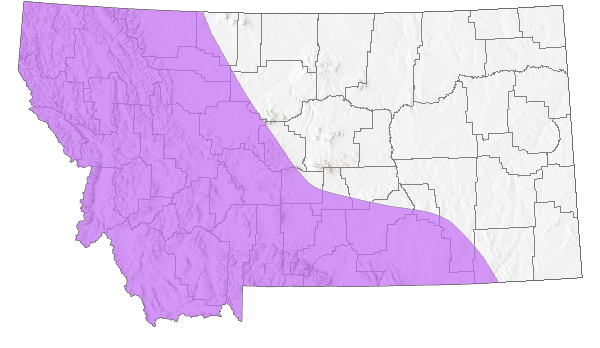
 Native
Native
Range Comments
Holarctic. In North America, Alaska south to central California, southern Idaho, northern Utah, southwestern Colorado, east across boreal and southern Canada to the northern Great Lakes region and northeastern Ontario, with isolated populations in Labrador, Newfoundland, southern Quebec, Nova Scotia (Scott 1986; Opler and Wright 1999: Glassberg 2001). Some authorities recognize P. anna as a distinct species from P. idas (Guppy and Shepard 2001; Pyle 2002; Warren 2005) in which case the range of idas would exclude the Cascades and Sierra Nevada; mostly 2745 m to 3355 m elevation but to 3658 m in Colorado (Brown 1957; Ferris and Brown 1981), 2134 m to 3353 m elevation in Wyoming (Nabokov 1953), usually above 914 m elevation in Oregon and Washington (Pyle 2002), 1158 m to at least 2438 m elevation in Oregon (Warren 2005), above 1000 m elevation in interior British Columbia (Guppy and Shepard 2001), 731 m to 1311 m elevation in southeastern British Columbia (Threatful 1988). In Montana, reported from the montane western 1/3 of the state (Kohler 1980; Stanford and Opler 1993). Locally uncommon to common (Glassberg 2001).
Observations in Montana Natural Heritage Program Database
Number of Observations: 38
(Click on the following maps and charts to see full sized version)
Map Help and Descriptions
Relative Density
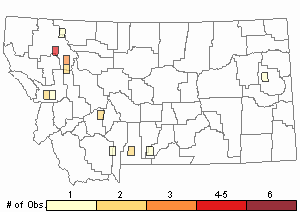
Recency
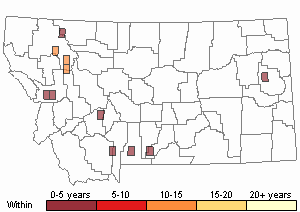
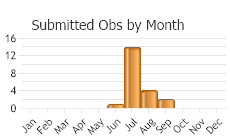

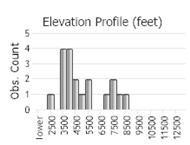 (Observations spanning multiple months or years are excluded from time charts)
(Observations spanning multiple months or years are excluded from time charts)
Migration
Non-migratory.
Habitat
Dry hills and flats, montane moist meadows, bog edges, trail sides and road cuts, above treeline in alpine tundra (Scott 1986; Opler and Wright 1999; Glassberg 2001; Guppy and Shepard 2001; Pyle 2002). In Glacier National Park, Montana reported from xeric and mesic montane meadows (Debinski 1993).
Food Habits
Larval food plants include Astragalus, Empetrum, Kalmia, Lathurus, Ledum, Lotus, Lupinus, Vaccinium, and Vicea (Ferris and Brown 1981; Scott 1986, 1992; Guppy and Shepard 2001; Pyle 2002). Adults feed on flower nectar (including Achillea, Anaphalis, Symphyotrichum, Trifolium) and mud (Scott 1986; Pyle 2002).
Reproductive Characteristics
Females lay eggs on host plant stems and in debris on the ground beneath host plant (Scott 1986; Guppy and Shepard 2001). Eggs diapause (overwinter). Eggs hatch in late spring a few days after introduction to warm conditions, develop from L1 instar to L4 instar and pupae in about 30 days (depending on temperature). Pupation occurs on upper surface of host plant leaves (in captivity) or in ant nests (in Europe), adults eclose (emerge from pupae) in about 12 days. Larvae solitary, build no nest, are associated with ants (Scott 1979, 1986; James and Nunnallee 2011). Males patrol throughout the day on flats and hillsides near host plants in bunch grassland, seeking females (Scott 1975b, 1986).
Stewardship Responsibility
References
- Literature Cited AboveLegend:
 View Online Publication
View Online Publication Brown, F.M. 1957. Colorado Butterflies. Proceedings; Numbers Three through Seven. Denver Museum of Natural History, Denver, Co.
Brown, F.M. 1957. Colorado Butterflies. Proceedings; Numbers Three through Seven. Denver Museum of Natural History, Denver, Co. Debinski, D. 1993. Butterflies of Glacier National Park, Montana. Occasional Papers of the Museum of Natural History, the University of Kansas, Lawrence, Kansas. No. 159: 1-13.
Debinski, D. 1993. Butterflies of Glacier National Park, Montana. Occasional Papers of the Museum of Natural History, the University of Kansas, Lawrence, Kansas. No. 159: 1-13. Ferris, C.D. and F.M. Brown (eds). 1981. Butterflies of the Rocky Mountains. Univ. of Oklahoma Press. Norman. 442 pp.
Ferris, C.D. and F.M. Brown (eds). 1981. Butterflies of the Rocky Mountains. Univ. of Oklahoma Press. Norman. 442 pp. Glassberg, J. 2001. Butterflies through Binoculars: A Field Guide to the Butterflies of Western North America. Oxford University Press.
Glassberg, J. 2001. Butterflies through Binoculars: A Field Guide to the Butterflies of Western North America. Oxford University Press. Guppy, C.S. and J.H. Shepard. 2001. Butterflies of British Columbia: including western Alberta, southern Yukon, the Alaska Panhandle, Washington, northern Oregon, northern Idaho, northwestern Montana. UBC Press (Vancouver, BC) and Royal British Columbia Museum (Victoria, BC). 414 pp.
Guppy, C.S. and J.H. Shepard. 2001. Butterflies of British Columbia: including western Alberta, southern Yukon, the Alaska Panhandle, Washington, northern Oregon, northern Idaho, northwestern Montana. UBC Press (Vancouver, BC) and Royal British Columbia Museum (Victoria, BC). 414 pp. James, D.G. and D. Nunnallee. 2011. Life histories of Cascadia butterflies. Corvallis, OR: Oregon State University Press. 447 p.
James, D.G. and D. Nunnallee. 2011. Life histories of Cascadia butterflies. Corvallis, OR: Oregon State University Press. 447 p. Kohler, S. 1980. Checklist of Montana Butterflies (Rhopalocera). Journal of the Lepidopterists' Society 34(1): 1-19.
Kohler, S. 1980. Checklist of Montana Butterflies (Rhopalocera). Journal of the Lepidopterists' Society 34(1): 1-19. Nabokov, V. 1953. Butterfly collecting in Wyoming, 1952. The Lepidopterists' News 7(2): 49-52.
Nabokov, V. 1953. Butterfly collecting in Wyoming, 1952. The Lepidopterists' News 7(2): 49-52. Opler, P.A. and A.B. Wright. 1999. A field guide to western butterflies. Second edition. Peterson Field Guides. Houghton Mifflin Company, Boston, Massachusetts. 540 pp.
Opler, P.A. and A.B. Wright. 1999. A field guide to western butterflies. Second edition. Peterson Field Guides. Houghton Mifflin Company, Boston, Massachusetts. 540 pp. Pyle, R.M. 2002. The butterflies of Cascadia: a field guide to all the species of Washington, Oregon, and surrounding territories. Seattle Audubon Society, Seattle, Washington. 420 pp.
Pyle, R.M. 2002. The butterflies of Cascadia: a field guide to all the species of Washington, Oregon, and surrounding territories. Seattle Audubon Society, Seattle, Washington. 420 pp. Scott, J.A. 1975b. Mate-locating behavior of western North American butterflies. Journal of Research on the Lepidoptera 14:1-40.
Scott, J.A. 1975b. Mate-locating behavior of western North American butterflies. Journal of Research on the Lepidoptera 14:1-40. Scott, J.A. 1979. Hibernal diapause of North American Papilionoidea and Hesperioidea. Journal of Research on the Lepidoptera 18(3): 171-200.
Scott, J.A. 1979. Hibernal diapause of North American Papilionoidea and Hesperioidea. Journal of Research on the Lepidoptera 18(3): 171-200. Scott, J.A. 1986. The butterflies of North America: a natural history and field guide. Stanford University Press, Stanford, California.
Scott, J.A. 1986. The butterflies of North America: a natural history and field guide. Stanford University Press, Stanford, California. Scott, J.A. 1992. Hostplant records for butterflies and skippers (mostly from Colorado) 1959-1992, with new life histories and notes on oviposition, immatures, and ecology. Papilio new series #6. 185 p.
Scott, J.A. 1992. Hostplant records for butterflies and skippers (mostly from Colorado) 1959-1992, with new life histories and notes on oviposition, immatures, and ecology. Papilio new series #6. 185 p. Stanford, R.E. and P.A. Opler. 1993. Atlas of western USA butterflies: including adjacent parts of Canada and Mexico. Unpubl. Report. Denver and Fort Collins, Colorado 275 pp.
Stanford, R.E. and P.A. Opler. 1993. Atlas of western USA butterflies: including adjacent parts of Canada and Mexico. Unpubl. Report. Denver and Fort Collins, Colorado 275 pp. Threatful, D.L. 1988. A list of the butterflies and skippers of Mount Revelstoke and Glacier National Parks, British Columbia, Canada (Lepidoptera). Journal of Research on the Lepidoptera 27(3-4): 213-221.
Threatful, D.L. 1988. A list of the butterflies and skippers of Mount Revelstoke and Glacier National Parks, British Columbia, Canada (Lepidoptera). Journal of Research on the Lepidoptera 27(3-4): 213-221. Warren, A.D. 2005. Lepidoptera of North America 6: Butterflies of Oregon, their taxonomy, distribution, and biology. Contributions of the C. P. Gillette Museum of Arthropod Diversity, Colorado State University. Fort Collins, Colorado. 406 pp.
Warren, A.D. 2005. Lepidoptera of North America 6: Butterflies of Oregon, their taxonomy, distribution, and biology. Contributions of the C. P. Gillette Museum of Arthropod Diversity, Colorado State University. Fort Collins, Colorado. 406 pp.
- Additional ReferencesLegend:
 View Online Publication
View Online Publication
Do you know of a citation we're missing? Allen, T.J., J.P. Brock, and J. Glassberg. 2005. Caterpillars in the field and garden: a field guide to the butterfly caterpillars of North America. Oxford University Press.
Allen, T.J., J.P. Brock, and J. Glassberg. 2005. Caterpillars in the field and garden: a field guide to the butterfly caterpillars of North America. Oxford University Press. Brock, J.P. and K. Kaufman. 2003. Kaufman Field Guide to Butterflies of North America. Houghton Mifflin Company, New York, NY 284 pp.
Brock, J.P. and K. Kaufman. 2003. Kaufman Field Guide to Butterflies of North America. Houghton Mifflin Company, New York, NY 284 pp. Caruthers, J.C., and D. Debinski. 2006. Montane meadow butterfly species distributions in the Greater Yellowstone Ecosystem. University of Wyoming National Park Service Research Center Annual Report, 2006. Vol. 30, Art. 14. 85-96.
Caruthers, J.C., and D. Debinski. 2006. Montane meadow butterfly species distributions in the Greater Yellowstone Ecosystem. University of Wyoming National Park Service Research Center Annual Report, 2006. Vol. 30, Art. 14. 85-96. Debinski, D.M., R.E. VanNimwegen, and M.E. Jakubauskas. 2006. Quantifying relationships between bird and butterfly community shifts and environmental change. Ecological Applications 16(1): 380-393.
Debinski, D.M., R.E. VanNimwegen, and M.E. Jakubauskas. 2006. Quantifying relationships between bird and butterfly community shifts and environmental change. Ecological Applications 16(1): 380-393.
- Web Search Engines for Articles on "Northern Blue"
- Additional Sources of Information Related to "Insects"





